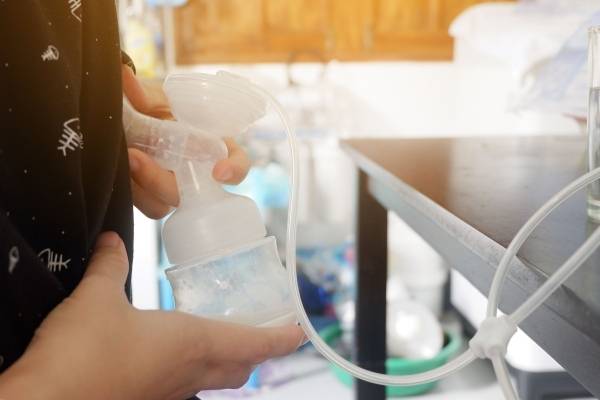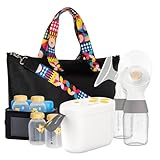These power pumping tips will be helpful if you need to increase your milk supply. In the first few weeks after giving birth, your breast milk supply will be at its peak as baby nurses on demand. However, as time goes on and you return to everyday life with working full time, exercising, and sleep cycles disrupted by a newborn – your milk supply can decrease.
Nursing moms need to know that there are ways to increase their milk supply when they need it. Enter power pumping, which is a technique that will mimic cluster feeding and helps encourage your body to produce more milk.
What is Power Pumping Breast Milk?
Power pumping works by simulating cluster feeding or mimicking what babies do when they nurse during a growth spurt. The baby nurses more often than usual but usually in short bursts. This stimulates your body to release prolactin, which will help increase breast milk supply.
It is essential to realize that you may not be producing milk during some of these pumping times. In the beginning, it is signaling to your body that more milk needs to be made. When your baby cluster feeds, they are naturally telling your body they need a bigger milk supply, and your body responds to produce more. Power pumping, also called cluster pumping is acting like your nursing baby.
How to Increase Milk Supply by Power Pumping?

So, how does power pumping work to increase milk supply? Unlike a regular pumping session, a power pumping session is an hour of interval pumping. Start by pumping on the low or medium-powered setting, and gradually increase the intensity to move up in intervals of around ten minutes. You can also do five minutes on high-mode followed by three minutes off until you have one hour spent power pumping.
So how do you do the pumping for this activity? It is very simple. The best way to start is by making sure that you are relaxed and comfortable before beginning the session. You can sit in a rocking chair, on the couch, or even in bed; in any position similar to breastfeeding. You can also choose to stand if you prefer, but sitting seems the most common way this activity is accomplished.
Sample Power Pumping Schedule
A typical pumping schedule has you pump on and off for a total time of one hour. If you use a single pump, there is no rest time because the one side you are not pumping is resting while you pump the other. You switch from left to right for a total of 60 minutes.
Double Pump Schedule:
-
20 Minute Pump
-
10 Minutes Rest
-
10 Minute Pump
-
10 Minutes Rest
-
10 Minute Pump
Single Pump Schedule:
-
10 Minute Pump Right Breast
-
10 Minute Pump Left Breast
-
10 Minute Pump Right Breast
-
10 Minute Pump Left Breast
-
10 Minute Pump Right Breast
-
10 Minute Pump Left Breast
Why Should I Try Power Pumping?
To increase supply and demand without adding a nursing session, you can power pump. Even with breastfeeding full-time, you may need an increase in breast milk production. Women notice that even with frequent feedings, they need to be making more milk if they want to build a supply or when their baby is going through a growth spurt. Enter power pumping.
If you want to build your milk supply for freezer storage, power pumping is one of the best ways. It’s crucial to power pump for an entire hour if you want the most milk, but doing it for even 15 minutes a day is good. Start pumping to stimulate your body to make extra milk. Power pumping works best when you do intervals with rest breaks between pumping times.
When to consider using this technique (including when your milk supply decreases)
There are many reasons why a new mother might need to increase their milk supply, and power pumping is one way to increase breastmilk production.
- When your milk supply decreases, or when your baby refuses or stops nursing frequently.
- When there are issues with breastfeeding due to latch issues, tongue tie, or lack of breast tissue
- As a last resort before formula feeding or if no other methods have worked
- If you wish to provide your baby with the benefits of breastmilk for the entire first year but do not plan to exclusively breastfeed.
- During a growth spurt when your baby requires more breast milk.
- If your baby is refusing or not latching well as a newborn, you can power pump to express colostrum.
Seek professional medical advice from your doctor or a lactation consultant if you need help with breastfeeding or feel your baby is not getting enough to eat through breast milk.
Benefits of Power Pumping

There are many benefits of power pumping. Some benefits are that it strengthens your letdown, encourages milk production, and is a natural way of increasing breast milk supply. You can also do it in your own home without any expensive equipment.
-
A great way to encourage milk production in mothers who are just starting out breastfeeding or those who have a low milk supply
-
Good for moms who need to continue working and need extra milk for bottle feeding
-
For moms who are exclusively pumping because the baby is too ill and cannot nurse
Disadvantages to Power Pumping
-
It can be exhausting to power pump for an hour straight
-
Cluster pumping can cause an oversupply if you do it at the same time as your baby cluster feeding
-
There is no evidence proving that power pumping increases breastmilk production significantly. However, most mothers note a positive result
-
Power pumping can cause sore nipples and even damage your breasts if done incorrectly
Steps for how to use this technique
1. You will need to use a breast pump. A good double or single pump would work. A hands-free bra will also make this process easier.
2. Continue to use a breast pump for an hour at 10-15 minutes intervals. This technique will mimic cluster feeding and will help encourage your body to produce a larger milk supply.
3. To avoid nipple soreness, let the suction stay on for a couple of seconds before releasing it. Also, use nipple cream or coconut oil after each pumping session. Check your pump parts; you may need a larger pump flange.
4. Use this technique in conjunction with baby nursing until you increase your milk supply significantly.
5. Store milk safely in a breast milk cooler if you are not near a fridge.
Best Breast Pump for Power Pumping
1. Medela New Pump in Style with MaxFlow
- Exact contents may vary -- We temporarily ran out of the tote bag...
- MAX OUTPUT: Hospital performance that's clinically proven technology...
- MAX EASE: Automatic letdown and massage mode cycles and an intuitive...
The Medela’s New Pump in Style with MaxFlow is a double electric breast pump designed for moms that want to do cluster pumping or are exclusively pumping. It has a closed system with overflow protection.
There are ten adjustable vacuum levels to have comfortable suction for all of your power pumping sessions. The pump parts are easy to clean and assemble, making this an efficient and easy-to-use breast pump.
2. Bellababy Double Electric Breast Feeding Pumps
- 1 Come with 2 pcs of milk storage bag adapters and 10 pcs of storage...
- Four modes and 9 levels of suction for choice,massage and stimulate...
- High definition Screen,display the working mode,suction level,time and...
The Bellababy breast pump is built for moms on the go. It is convenient to take anywhere and has a built-in battery to use anywhere, including outdoors. It is a completely closed system and is a hospital-grade pump.
There are four modes and nine levels of suction so that you can customize it to your individual needs. It is also hushed, so your pumping sessions won’t wake your baby. The bright LED display makes it easy to use. This is an excellent pump if you are exclusively pumping or when you just need to power pump for more milk.
3. Power Pumping Spectra Pumps
Many women and lactation consultants worldwide love the Spectra Breast Pumps, and it is easy to see why. These pumps are quiet and discreet; they even have a built-in night light for those late-night pumping sessions.
A massage mode simulates the natural suckling to make for a more natural milk flow and a comfortable pumping experience. Find out which one would be best for you in our post about the differences: Spectra S1 vs. Spectra S2.
Best Power Pumping Single Pump
4. Medela Swing, Single Electric Breast Pump
- COMPACT & LIGHTWEIGHT MOTOR: This single breast pump includes a...
- RESEARCH-BASED TECHNOLOGY: Unique to Medela breast pumps, this...
- EASY-TO-USE CONTROLS: A single pumping kit with 24mm PersonalFit...
Are you looking for a single pump? The Medela Swing is a compact and lightweight pump that would be perfect for you. It features a 2-Phase expression technology that mimics your baby and creates an effective and natural way to remove milk.
The Medela Single pump fits neatly in your purse so that you can take it anywhere. The vacuum controls let you adjust the suction and power to suit your individual needs.
Don’t forget a Haaka to collect any letdown milk on your non-pumping breast. You don’t want to lose any of your valuable breastmilk!
- Haakaa Silicone Breast Pump & Ladybug Milk Collector Combo aim to give...
- Simple Haakaa Manual Breastpump Easy to Use. When nursing, the quiet...
- Haakaa Ladybug Milk Collector Collects Each Drop. Even if you are...
List of tips on how to make the most out of your power pumping sessions
1. Make sure to get enough fluids during a power-pumping session.
2. Power pump in intervals for 10-20 minutes at a time, with 10 minutes rest in-between each session.
3. Use a hands-free bra to make the process easier and more productive. Check out these top sellers!
4. Stay hydrated throughout the day.
5. Focus on relaxing while you’re double pumping, whether it’s watching TV or listening to soothing music.
6. Be sure to power pump for at least one hour per day for about a week.
7. Reduce stress in your life.
8. Eat protein-rich foods and have snacks on hand in case you get hungry during your pumping routine.
9. Take a hot shower before pumping to increase milk flow.
10. Use a massage tool to help encourage letdown, speed up the process of power pumping and prevent clogged ducts.
FAQs about Power Pumping for New Moms
1. How long does it take for power pumping to work?
It is impossible to say how long it will take for the technique to succeed. It can depend on many factors, such as your body’s ability to produce milk, your diet, and how often you are trying this technique.
Some women find that they have a lot of success with power pumping when introducing other tips. For example, some women succeed by drinking mother’s milk tea and nursing more often than regular pumping.
2. Can I power pump while I nurse?
It is not recommended for women to power pump and nurse baby simultaneously. This can cause an oversupply. Women power pump about 20-30 minutes after their baby has been nursed and had enough to eat so that they don’t interfere with their baby’s needs.
After you have nursed your baby, power pumping will ensure you empty your breasts and stimulate your body to make more milk.
3. How often should I do power pumping?
There’s no standard about how often you should do power pumping. It can depend on how much time you have available, your energy levels, or other factors. Be sure to talk to your doctor before giving up if there isn’t an immediate change in milk supply.
The best thing for any new mom is to establish healthy habits early on and honor her body’s need for sleep and rest as she adjusts to a baby during the night. For most women, power-pumping helps increase breastmilk production substantially while preserving their health and sanity when they only do it once a day.
4. Is power pumping harmful?
The short answer is no. The power pumping technique mimics a natural feed in many ways, and just as with breastfeeding, there’s a learning curve to find the right balance of when to pump, how long to pause for each rest, and how often you should do it during the day.
The key is that power-pumping, also called cluster pumping, isn’t meant to replace normal breastfeeding. But, if your milk supply slows at all while you’re still doing what feels like enough of everything else, it can be helpful in those moments to boost production.
5. How much milk do you get from power pumping?
One study found that women who power pump had an average increase of 150-300 grams per day or 8.3-12.8 oz per day. The amount of breast milk depends on the individual and may vary even among mothers who are pumping more than twice a day for the same length of time.
While there’s also no one standard as to how much breast milk you can expect to pump with power pumping, and it varies in every case, it is worth noting that if you have any immediate success at all, then it is something your body will cooperate with (and get to).
6. Does power pumping work?
Power pumping has been known to help moms increase their breastmilk supply by 25%, so this technique is worth trying–especially if you’ve endured any related struggles up until now. It is always a balancing act and process of trial and error—a lifestyle change that new moms will have to adjust to.
It is important to note that it is easier to stimulate and increase breast milk supply when you frequently feed more than once every 24 hours. You can ease into power pumping by trying it even less often at first, waiting longer between pumps if your body needs more time between sessions.
7. What if my supply doesn’t increase? How many days should I wait before trying again?
If you power pump and your baby seems content for feedings for a while, then there’s no need to rush back into it if you don’t want to. And there’s definitely no need to beat yourself up over not seeing results in the first week. It may take time to establish a new routine.
If you are doing at least one cluster feed each day and still aren’t seeing any increase in your breast milk supply after 3 days, then it may be time to add another power pumping session. But if you have already tried that and your baby is still getting enough milk during the cluster feeds, then it’s likely going to take a little bit longer than anticipated for you to start seeing substantial results from power pumping.
Most won’t see results immediately and may need to power pump for a few days or even weeks before anything really changes. Some things to keep in mind: If you are doing at least one cluster feed each day, if your power pumping session lasts for at least 30 minutes (with 10 minutes rest in between sessions), and if your baby is not gaining weight as expected during this time…then chances are, you need to: a.) Keep pumping more frequently. b.) Pump longer. c.) Continue adding cluster feeds so that eventually, your breasts have time to build supply.
8. When is the best time to power pump?
The best time to power pump is during the day or early evening. Usually, about 20-30 minutes after nursing baby. These times are when your milk production is highest. If you are worried about milk supply, then try to pump during the times when your baby eats most often. Ideally, this would be at least once every 3 hours.
9. Is Power Pumping the only way to increase breastmilk supply?
No. There are other ways to increase breastmilk supply that include:
-
Feeding on demand as baby needs it
-
Offer both sides during each feeding
-
Eat Lactation Cookies
-
Breast Massage while nursing or pumping
-
Get added rest, reduce stress
-
Eat oats and other whole grains
-
Add fenugreek seeds to your diet
-
Use a manual pump
Conclusion
Power pumping is a great way to help increase your supply naturally. It is interval pumping with 10-20 minutes pumping and 10 minutes rest that will mimic cluster feeding of a baby and gives you what your baby enough milk. If you need a boost in your supply, power pumping will do it. Your body thinks it needs to produce more milk.
It is important to note that power pumping alone may not be enough to increase milk supply. You want to be taking care of yourself and make sure you are getting enough calories throughout the day to account for all the pumping sessions. You may also have to add things like oats, brewers yeast, or fenugreek to your diet. It is essential to make sure you are staying hydrated too.
Power pumping is worth trying because it has been shown to yield an average 25% increase in breastmilk production over normal pumping, but don’t get discouraged if it doesn’t work for you right away or at all! The key is figuring out how many of these methods will actually work for you before giving up on them altogether–so keep pumping and experimenting until something sticks!
All opinions are my own and are not to be considered medical advice. Talk to your doctor or lactation consultant if you have concerns or questions.















